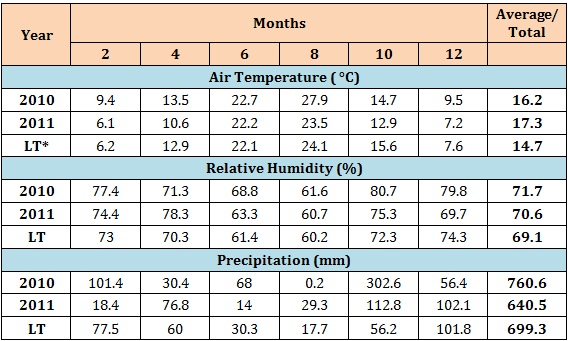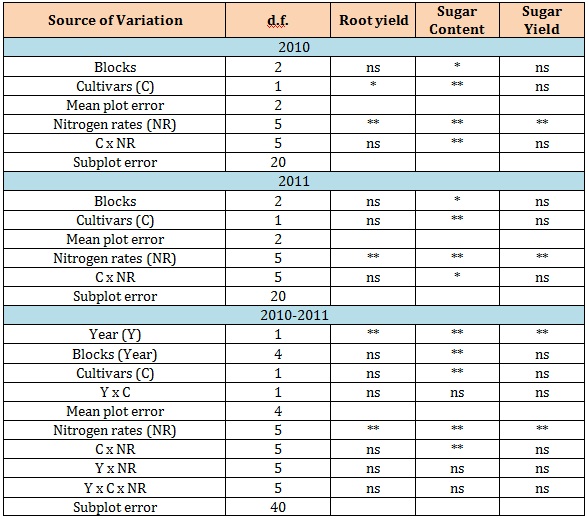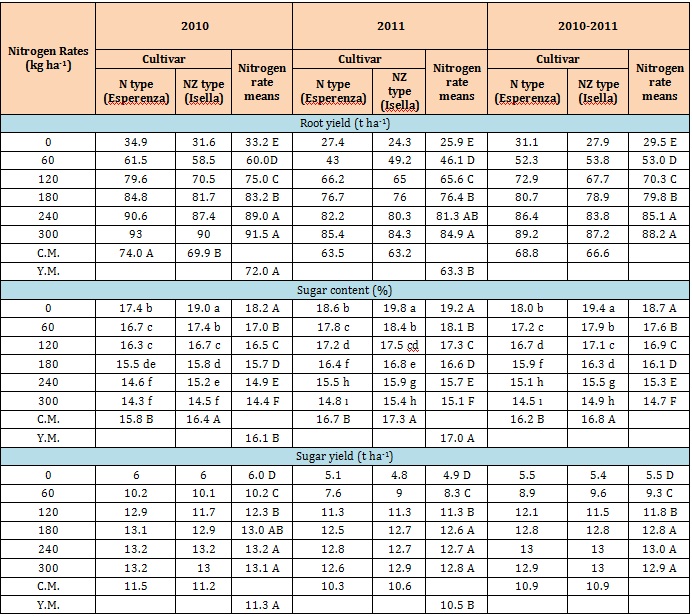
Citation: Sincik M and Canigenis T. The Effects of Different Nitrogen Rates on Root Yield and Quality of N and NZ Type Sugar Beet Varieties. J Agri Res 2016, 1(1): 000105.
*Corresponding author: Mehmet Sincik, Department of Field Crops, Faculty of Agriculture, Uludag University, Turkey, E-mail: sincik@uludag.edu.tr
This research was conducted to determine the effects of different nitrogen fertilizer rates (0, 60, 120, 180, 240 and 300 kg ha-1) on root yield and quality of N (Normal) type Esperenza and NZ (between Normal and Zucker = Sweet) type Isella sugar beet cultivars in The Agricultural Research and Application Center of Uludag University Faculty of Agriculture in 2010 and 2011. As a result of the research, the highest root yield values obtained from 240 and 300 kg ha-1 nitrogen rates. Also, the highest sugar content was taken from 0 kg ha-1 control dose. But, the highest sugar yields per unit area obtained from 180, 240 and 300 kg ha-1 nitrogen applications. In terms of sugar yield there were not found statistically important differences between N and NZ type sugar beet varieties.
Keywords: Nitrogen; Root yield; Sugar beet; Sugar content; Sugar yield
Sugar beet is an important plant grown commercially for sugar and alcohol production. Extensive researches should be conducted to increase of the yield of this crop. Between all elements of mineral nutrition, nitrogen has the highest effects on root yield and quality of sugar beet. Sugar beet absorb nitrogen in considerable quantities, but optimum quantity is set within limited range. In increased nitrogen supply sugar beet absorb nitrogen wastefully, with negative effect to production results [1]. The insufficient nitrogen fertilization has a negative effect on sugar beet root yields, while excessive nitrogen application decreases technological value of sugar beet roots, which has been proved in various research findings [2-5]. When fertilizer and sugar beet prices compared, it is stated that 100-110 kg N ha-1 seen enough nitrogen rates [6]. Consistent with this result, 125 kg N ha-1 nitrogen dose is sufficient for maximum sugar beet yield in Germany [7]. In accordance to those findings, optimum N doses for sugar beet higher than 200 kg N ha-1 in the Netherlands and USA [8,9]. Similarly, in USA, nitrogen rate recommendations are location-specific and usually range from 56 to 179 kg N ha-l , although rates up to 364 kg N ha-1 are suggested for some locations [10].
The aim of this work was to study the effects of different nitrogen rates on root yield and quality of N (Normal) type Esperenza and NZ (between Normal and Zucker) type sugar beet varieties under irrigated, Mediterranean conditions.
Materials and MethodsExperiments were conducted during 2010 and 2011 at the Applied and Research Centre for Agriculture, Uludag University, Faculty of Agriculture, Bursa, Turkey (40° 11´ N, 29° 04´ W). The soil was a clay (average 58.6% clay content) textural class. Soil samples were collected from the 0–0.30 and 0.30–0.60 m profiles and analyzed. Soil test levels of the experimental area in 2010 and 2011 were: pH 7.5 and 7.9, 1.9% and 2.2% organic matter, 63.6 and 121.3 kg ha-1 extractable P, 844 and 1310 kg ha-1 exchangeable K and 4.12 and 4.57% CaCO3, respectively.
The experimental site is located in the Southern Marmara region, Turkey, with an average annual rainfall of 700 mm, average annual relative humidity of 69.1% and a mean monthly temperature of 14.7 ºC. Climatic data were obtained from the nearest weather station in Bursa (Table 1).
The total rainfall from April to October was 475.0, 298.2 and 281.4 mm in 2010, 2011 and long term (1929-2005), respectively.
The experimental plots were arranged in a split plot design with three replications in both years. The N (Normal) type Esperenza and NZ (between Normal and Zucker) type sugar beet cultivars were the main plots, and six different nitrogen levels 0, 60, 120, 180, 240 and 300 kg N ha-1 were the subplot treatments. The subplot size was 10.8 m2 (1.8 × 6.0 m) and consisted of four planting rows, with the middle two rows designated as harvest rows.
The crop previously grown in the experimental area in both years was sunflower (Helianthus annuus L.). The experimental area was cultivated by ploughing at a depth of 25-30 cm in the autumn and by disc-harrowing at 8-10 cm depth in the spring. Sugar beet seeds were hand planted on 29 April 2010 and 27 April 2011 at 0.45 m between-row spacing and 0.20 m within-row spacing. Prior to planting, triple super phosphate and potassium sulphate were incorporated into the disc-harrowed soil at 100 kg ha-1 P2O5 and K2O. Half the nitrogen rate was applied before planting and the remaining N was top dressed before the first irrigation. The N fertilizers were banded urea, approximately 5 cm below and to the side of the seed row. The plots were harvested by hand on 08 November 2010 and 14 November 2011. At the harvest, 2 rows in the middle were taken into consideration. The net weights of roots were determined by a steelyard scale after cleaning with pressured water and reported in kg ha-1 units. Sugar content (%) was estimated in fresh samples of sugar beet root by using saccharometer according to the method described by [11]. Sugar yield was calculated using the following formula:
Sugar yield (kg ha-1): Root yield (kg ha-1) × Sugar content (%).
All of the data were subjected to an analysis of variance for each variable using SAS software version 3.1. Interactions of the main effects, year, cultivar and nitrogen rate, were determined at the 0.05 and 0.01 probability levels. The F-protected least significant difference (LSD) was calculated at the 0.05 probability level.
Results and DiscussionThe analysis of variance demonstrated that the years significantly affected all of the traits measured. Significant cultivar differences were found for root yield, and sugar content in 2010; for sugar content in 2011 and combined years. According to both the data combined over two years and the individual years, the nitrogen rates significantly affected all of the observed traits. The cultivar (C) × nitrogen rate (NR) interaction was significant at a 1% probability for the sugar content in combined years (Table 2).
The highest root yield obtained from N type cultivar Esperenza in 2010. In contrast to above result, the highest sugar rates provided by NZ type cultivar Isella in 2010, 2011 and combined years. But, there was no significant difference between the sugar yield of the N and NZ type sugar beet varieties in the individual years and the data combined over two years (Table 3).
Sugar beet varieties are usually classified as being Etype (with emphasis on root yield, Ertrag), Z-type (with emphasis on sugar percentage, Zucker), N-type (Normal, intermediate in both characters) or NZ-type (Between the N and Z types). Although, in recent years, there has been a general demand for varieties with higher sugar percentage, choice of varietal type for any particular area is influenced by several factors, including climate and system of payment for roots [12].
As the N rates increased, all of the traits significantly increased, except the sugar content in the individual years and the data combined over two years. The highest root and sugar yields were obtained at 180-300 kg ha-1 N rates. When the nitrogen rates increased from 0 to 300 kg ha-1 N, root yield ranged from 33.2 to 92.5 t ha-1 in 2010, 25.9 to 84.9 t ha-1 in 2011 and 29.5 to 88.2 t ha-1 in combined years (Table 3). It was stated that root and sugar yield were significantly increased with increasing nitrogen fertilizer rates (143, 214 and 285 kg N ha-1) over two seasons [13]. Similarly, sugar beet root yield was the highest on the fertilization variants with the highest amounts of nitrogen fertilizer [14].
Sugar content is reduced when the nitrogen rates increased in 2010, 2011 and combined years (Table 3). Increasing nitrogen rates decreased sugar content because of increased moisture level of roots and dry matter produced and accumulated in the roots having decreased sugar content [15]. Similar results were reported by other researchers [16,17].
ConclusionsOur findings revealed that sugar yield is not affected by N and NZ type sugar beet cultivars. The root yield and sugar yield increased significantly when nitrogen fertilization rates increased. The highest root and sugar yields were obtained at 180-300 kg ha-1 N rates. An increase of nitrogen fertilization rates caused decrease in sugar content. The highest sugar content obtained from 0 kg ha-1 N rates (control dose) in both investigation years.

*Long-Term (1929-2005)
Table 1: Climatic data of the experimental years.

d. f.: Degree of freedom; ns: not significant; *: Significant at 0.05 probability level; **: Significant at 0.01 probability level
Table 2: Results of variance analysis of some important traits of N and NZ type sugar beet cultivars applied different nitrogen doses.

C.M: Cultivar mean; Y.M.: Year mean
Table 3: Average values of some important traits of N and NZ type sugar beet cultivars applied different nitrogen doses.